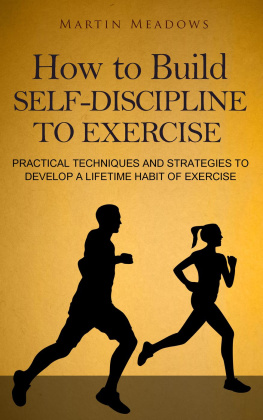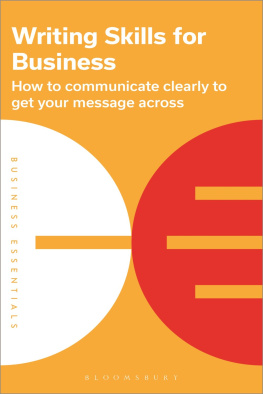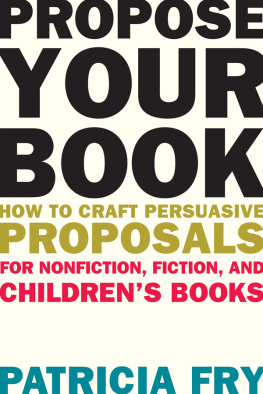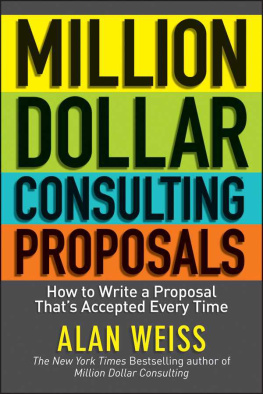
How to Build
Self-Discipline to Exercise
Practical Techniques and Strategies to
Develop a Lifetime Habit of Exercise
By Martin Meadows
Download another Book for Free
I want to thank you for buying my book and offer you another book (just as valuable as this book), Grit: How to Keep Going When You Want to Give Up , completely free.
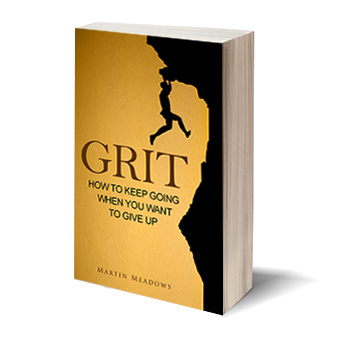
C lick the link below to receive it:
http://www.profoundselfimprovement.com/selfdisciplinetoexercise
In Grit , Ill share with you exactly how to stick to your goals according to peak performers and science.
In addition to getting Grit , youll also have an opportunity to get my new books for free, enter giveaways, and receive other valuable emails from me.
Again, heres the link to sign up:
http://www.profoundselfimprovement.com/selfdisciplinetoexercise
Table of Contents
Prologue
I magine theres a pill that improves your ability to resist temptations and persevere. Your life is now so much better because its so much easier to achieve your goals. The pill also provides other benefits like:
- a significant decrease in perceived stress and emotional distress,
- reduced smoking, alcohol and caffeine consumption,
- an increase in healthy eating,
- improved emotional control,
- an increase in attendance to commitments and maintenance of household chores,
- an increase in monitoring of spending,
- an improvement in study habits.
There are no side effects, and its vastly available everywhere you go for free or a very low price. How many pills would you like to order today if such a pill existed?
Well, it actually does exist, though not in pill form. Its called exercise . All of the benefits listed above come from a 2006 Australian study on 24 non-exercisers between 18 and 50 who regularly exercised for a 2-month period (just once a week for the first month and three times a week for the second month)[i], and its just one out of hundreds, if not thousands, of studies exploring the positive effects of exercise.
Theres no question that regular physical activity is not an option its a necessity for both your mind and your body.
The aforementioned pill would instantly become a global bestseller. Unfortunately, exercise doesnt sell that well. The 2014 United States American National Health Interview Survey (NHIS) paints a dire picture. Among adults aged 18 and over, 30.2% of Americans are considered inactive with respect to aerobic activity guidelines and 19.8% of them are insufficiently active[ii].
Moreover, only 3.2% met full muscle-strengthening guidelines, 28.5% met full aerobic activity guidelines and just 21.4% met full guidelines for both aerobic activity and muscle strengthening.
According to a 2009 study[iii], the second most common barrier for exercise habit (after a lack of support) was a lack of willpower. Herein lies the difficulty in marketing exercise something taking time and effort when compared to a pill generating instant results.
Fortunately, while the magic pill doesnt exist, exercise does. It also isnt so hard to introduce into your life that you need to wait for the pill to appear. All you need are proven practical techniques and strategies to form a habit of exercise.
As the author of books like How to Build Self-Discipline: Resist Temptations and Reach Your Long-Term Goals , Daily Self-Discipline: Everyday Habits and Exercises to Build Self-Discipline and Achieve Your Goals , and Self-Disciplined Dieter: How to Lose Weight and Become Healthy Despite Cravings and Weak Willpower , self-discipline is my main area of expertise.
I want to help you break through the most common barriers for making exercise a part of your life and finally develop a permanent habit of it so you can become healthier, more vibrant, joyful, and enjoy other benefits regular physical exercise provides.
In the following pages youll learn:
- how to get motivated to exercise. Well dig deep into three different kinds of motivation, two additional opposing types of motivation, and how they can all help you get more active. Well also cover practical strategies to handle procrastination;
- how to find time to exercise, which is a common reason why people are inactive. Youll learn about the horrible trade-off youre making when you dont exercise because of a lack of time. Youll also learn when to exercise and numerous non-obvious ways to make more time for exercise;
- how to stay motivated to exercise. Often its easy to start, but hard to keep going. Youll learn a wide variety of ways to improve motivation, how to take a break and not destroy your habit of exercise, as well as discover how to prevent injuries, reduce soreness, and improve recovery so you cant make excuses because of pain;
- how to enjoy exercise. Tips on how to enjoy exercise are peppered throughout the book, but in this chapter well focus entirely on the simplest (and most effective) piece of advice that will most likely transform your entire attitude toward exercise (if youve always had trouble maintaining a regular exercise habit, its possible youre the victim of this bad approach, often praised in fitness gyms);
- how to deal with other exercise-related issues like dealing with other people, managing your expectations related to physical activity, and dealing with discomfort, self-criticism, and feeling awkward when visiting the gym for the first time or trying a new sport.
If you havent been exercising for a long time, chances are youve grown to believe exercise is not for you or that youre not strong enough either mentally or physically to act on the knowledge from this book.
Fortunately, nothing can be further from the truth, and there are simple though not always easy ways to fix this attitude. When put together and acted upon, the six chapters in this book supported by over 80 references to scientific studies and credible experts will help you form a new habit and make one of the most important changes youll ever make in your life.
Lets embark on the journey now to learn how.
Chapter 1: How to Get Motivated to Exercise
I f youre anything like most people struggling to get motivated to exercise, knowing that physical activity is good for you means nothing. You need something more to inspire you to get off the couch and move your body, but youre not sure what.
Out of all the challenges related to forming a habit of regular exercise, getting started is probably the most difficult thing. For this reason, this chapter will cover exactly how to overcome laziness or reluctance and start exercising.
Well start with covering three different types of motivation and how they can help you start exercising. In addition to discussing them, well talk about push and pull motivations and how most people choose the wrong P and give up when they face obstacles.
Next, well dig deep into one of the most powerful ideas to get yourself motivated for exercise and keep exercising. With this simple but slightly uncomfortable trick you can light a fire under yourself that will ensure youll get plenty of exercise.
Last but not least, well move on to the issue of procrastination and how to finally stop postponing exercise. Its tricky to start exercising if you have a habit of putting everything off for later. Youll learn how to make exercising an automated behavior so you dont have to exert your willpower each time you need to get active.
Without further ado, lets start by discussing three types of motivation: extrinsic, intrinsic, and prosocial.
Next page
